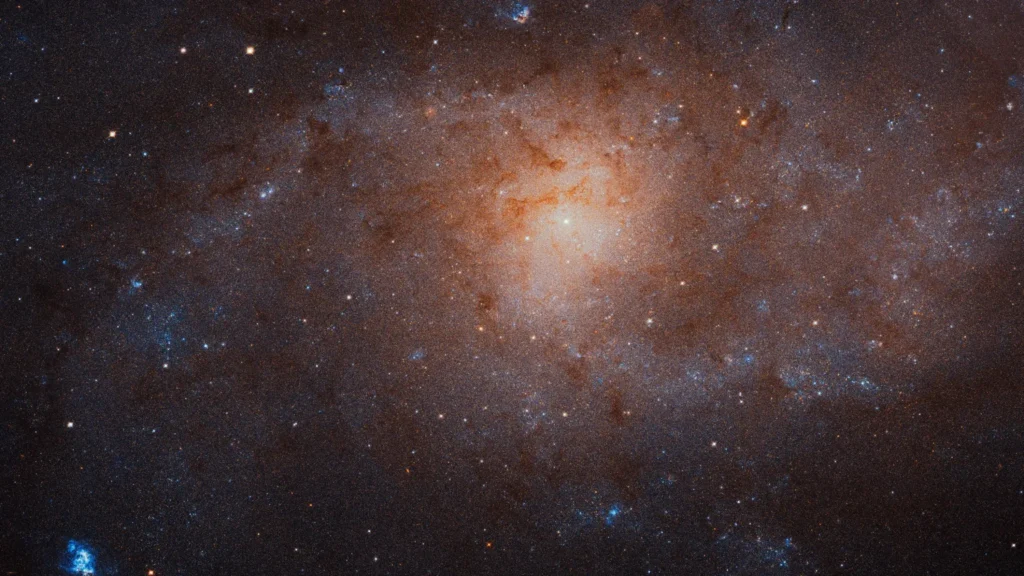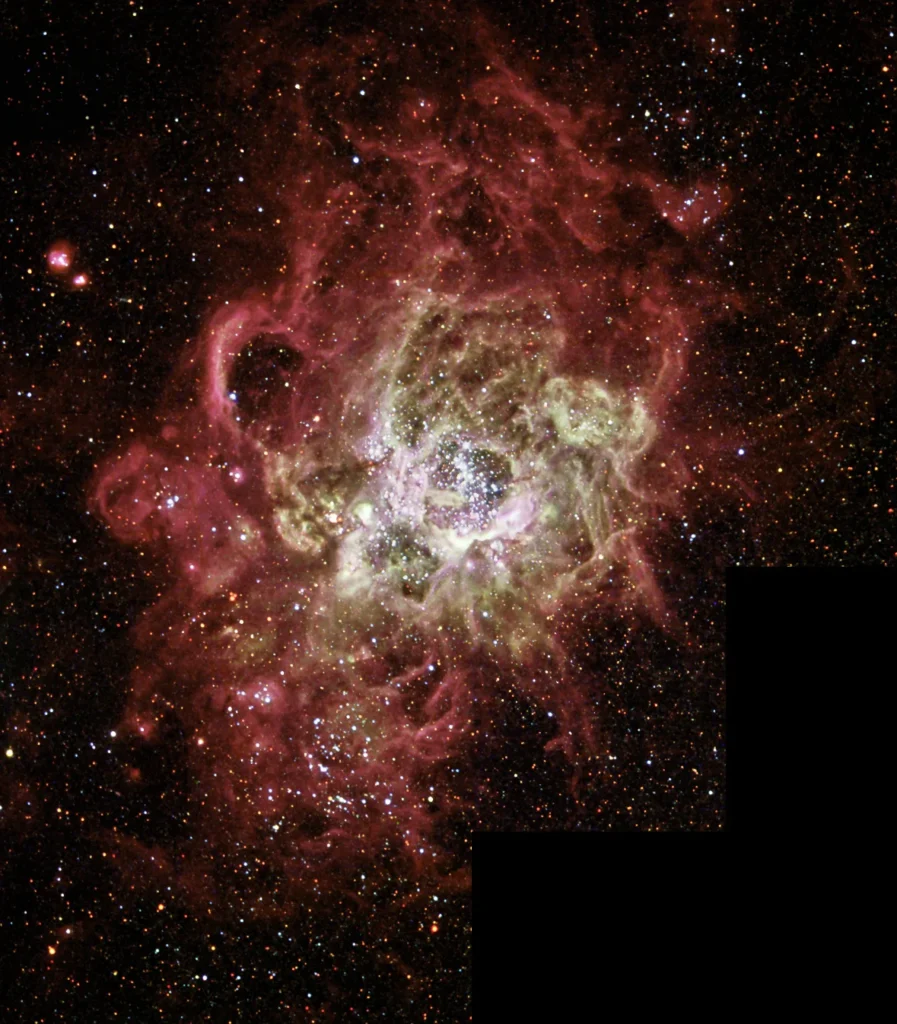The universe is filled with countless wonders, but few galaxies capture the imagination quite like the Triangulum Galaxy, also known as Messier 33 (M33). Let’s dive deeper into what makes M33 so special and why these recent observations are so significant.
M33’s Unique Place in the Local Group of Galaxies
M33 stands out in our Local Group of galaxies, which includes the Milky Way and the Andromeda Galaxy. Despite being smaller than these two giants, M33 holds a unique place in the group’s dynamics. Located about 3 million light-years away, M33’s spiral structure is well-organized, featuring prominent arms that are free of the chaotic distortions usually caused by interactions with other galaxies. This pristine structure is a key indicator that M33 has experienced little to no significant galactic collisions, unlike many other spiral galaxies where such interactions often drive dramatic bursts of star formation.

NASA, ESA, and M. Durbin, J. Dalcanton and B. F. Williams (University of Washington)
Astronomical studies, including those using the Hubble Space Telescope, show that M33’s lack of interaction with nearby galaxies contributes to its organized appearance. As observed by researchers, the clean spiral arms of M33 are not disrupted by gravitational forces from neighboring galaxies, which suggests a relatively isolated history. This makes M33 a valuable case study for understanding how galaxies evolve when left largely undisturbed by their cosmic neighbors.
By studying galaxies like M33 that are not significantly shaped by collisions, astronomers can better understand the natural evolution of spiral galaxies. It helps isolate factors such as internal star formation processes and the distribution of gas and dust that define a galaxy’s lifecycle.
Star Formation: M33’s Stellar Birth Rate Outshines Andromeda
One of the most fascinating aspects of M33 is its impressive rate of star formation. The Triangulum Galaxy is forming stars at a rate ten times higher than its neighbor, the Andromeda Galaxy (M31). This star-forming frenzy is driven by the abundance of dust, gas, and ionized hydrogen regions, also known as H-II regions, which are crucial for stellar birth. These regions are particularly dense in M33, making it a veritable nursery for new stars.
Ionized hydrogen clouds, or H-II regions, are the primary sites of star formation in galaxies. In M33, these regions are plentiful, giving rise to new stars at a much faster pace than in more quiescent galaxies like Andromeda. Among these star-forming regions, NGC 604 stands out as one of the most enormous and active nebulae within M33. Spanning almost 1,500 light-years, NGC 604 is nearly 100 times larger than the Orion Nebula in the Milky Way and contains over 200 hot, massive, young stars. This immense concentration of stars produces intense ultraviolet radiation that ionizes the surrounding hydrogen gas, creating a glowing, expansive nebula that signifies rapid star formation.

NASA and the Hubble Heritage Team (AURA/STScI); acknowledgment: D. Garnett (U. Arizona), J. Hester (ASU) and J. Westphal (Caltech)
According to studies conducted using the Hubble Space Telescope, the presence of massive molecular clouds colliding within M33 further accelerates this process, leading to the formation of high-mass stars. As reported by NASA, these collisions create the conditions needed for gas to condense and ignite, sparking the birth of new stars across the galaxy.
The Enigma of M33’s Missing Supermassive Black Hole
Most spiral galaxies, especially those as large as M33, contain a central bulge filled with densely packed stars and often a supermassive black hole. However, M33 breaks the mold as a “pure disk galaxy” — a term used to describe galaxies without a central bulge and lacking evidence of a supermassive black hole. This rarity puts M33 in the company of only about 15-18% of known galaxies, making it a compelling subject for further study.
The absence of a supermassive black hole in M33 challenges conventional theories about galaxy formation and evolution. In most cases, supermassive black holes are thought to form early in a galaxy’s life and significantly influence its development through gravitational forces and energetic feedback. However, M33’s status as a pure disk galaxy suggests that there might be alternative pathways for the evolution of spiral galaxies that do not involve a central black hole.
A Future Collision Course with Andromeda and the Milky Way
While M33 has enjoyed a relatively undisturbed past, its future might not be so serene. Astronomers have predicted that M33 is on a possible collision course with both the Andromeda Galaxy and, eventually, the Milky Way. Such galactic interactions could dramatically reshape M33’s structure, potentially triggering new waves of star formation or merging its stars into a larger galactic system.
The gravitational pull between galaxies in close proximity can eventually lead to collisions, a process that has shaped many galaxies throughout the universe. As galaxies merge, their stars, gas, and dust interact, often leading to intense starburst activity. For M33, colliding with Andromeda could mean the end of its neatly organized spiral arms, transforming it into a more chaotic system or merging it into Andromeda’s already massive structure.
The Role of the Hubble Space Telescope and Future Observations
The recent imaging of M33 by the Hubble Space Telescope showcases the continued relevance of this aging observatory in the era of the James Webb Space Telescope (JWST). While JWST brings incredible infrared capabilities to the table, Hubble remains invaluable for capturing high-resolution images in the visible spectrum. This data is crucial for refining theories related to the interstellar medium, star formation processes, and stellar evolution.
Despite the arrival of JWST, Hubble continues to provide data that is complementary to infrared observations. Its ability to resolve individual stars in galaxies like M33, which are close enough for detailed study, makes it indispensable for certain types of astronomical research. For M33, Hubble’s recent images help astronomers map star formation regions and study the intricate structures of ionized hydrogen clouds and dust lanes.
As both Hubble and JWST continue to operate, the combination of their data will provide a more comprehensive understanding of galaxies like M33. Future studies may focus on unraveling the mysteries of M33’s missing supermassive black hole, its ongoing star formation, and the galaxy’s potential future interactions with Andromeda and the Milky Way.



















